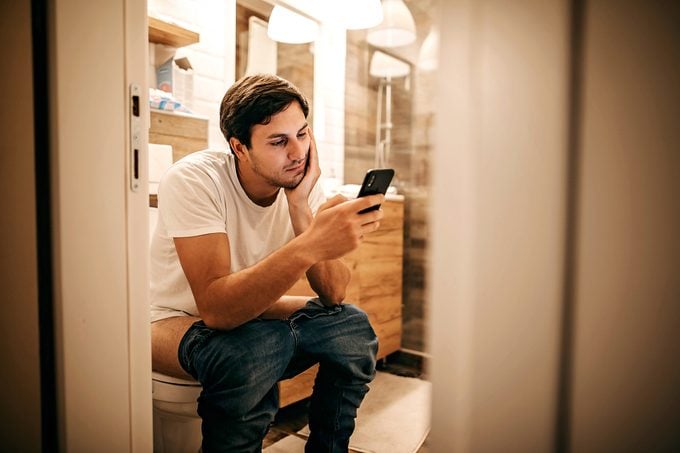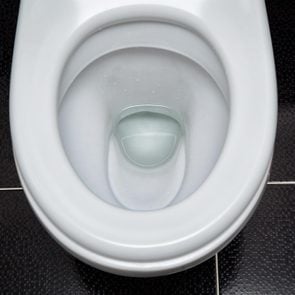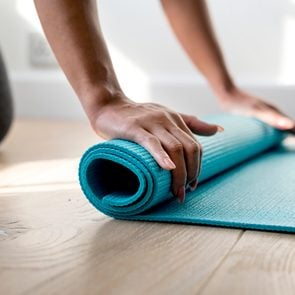How Gross Is It to Bring Your Phone Into the Bathroom?
Updated: Nov. 29, 2023
Bringing your phone into the bathroom can be a germ-spreading habit with consequences.
Our editors and experts handpick every product we feature. We may earn a commission from your purchases.
Using your phone on the toilet
Are you reading this article on the toilet? If so, no judgement here. We’ve all done it.
Taking your phone into the bathroom is kind of like peeing in the shower. Everyone knows it’s gross, but many people do it anyway.
Three in four Americans confess to using their phone on the toilet, with 96% of Gen Zers saying they won’t even go into the bathroom without their phone, according to a survey of 2,114 people done by Bank My Cell, a trade-in gadget company. (Weird fact: 40% of survey respondents said they use their phone to set “mood music” for using the toilet.)
Germ researchers are well aware of this potentially dirty habit.
“I see people take their phone into the bathroom all the time, and cell phones do pick up lots of germs,” says Charles Gerba, a microbiologist at the University of Arizona who studies microbe transmission through everyday household objects.
So we’re not necessarily here to convince you not to take your phone to the bathroom, but we do want to signal you about the consequences it has and what you can do to be as hygienic as possible.
The 6 Worst Germ-Swapping Habits to Officially Stop Doing
Your phone is 10 times dirtier than a toilet seat
One of the worst places to use your phone is in the bathroom because when you flush the toilet germs spray everywhere, including on your phone, says Emily Martin, associate professor of epidemiology at the University of Michigan.
The problem is that most of us don’t think of phones as dirty. You may make sure to wash your hands after each and every time you use the bathroom, but you probably aren’t also cleansing your phone, she says.
Yet it’s been everywhere your hands have been—and then you hold it right up to your eyes, nose, mouth, and ears.
It may have even more germs than other bathroom items, including the toilet seat you’re sitting on, says Gerba.
This is because toilets get cleaned and sanitized on a regular basis, but most people don’t have a regular cleaning schedule for their phones (if they remember to clean them at all).
Research Shows This Gross (but Common) Behavior May Increase Alzheimer’s Risk
What the science says
If you’re a healthy adult, your immune system does a pretty great job of keeping germs out. But that doesn’t mean it’s fine to handle a bacteria-laden phone all day long.
People can and do get sickened by pathogens they pick up from ordinary objects all the time, and your phone is one of the worst offenders, says Gerba.
An estimated 92% of phones were contaminated with potentially problematic bacteria, according to a study done by the London School of Hygiene and Tropical Medicine.
Researchers swabbed over 300 samples from 12 cities across the UK and also found that 16% were positive for E. coli (Escherichia coli), a type of bacteria found in fecal matter that sickens over 265,000 people in the United States every year. Results varied widely from city to city, with nearly half of one town’s phones showing fecal matter.
How Often Should You Wash Your Sheets? Here’s What Germ Experts Recommend
A 2020 study done in the United States shows that germy phones aren’t just a UK problem.
Volunteers swabbed over 3,500 phones at sporting events across the country and researchers sequenced the DNA of each sample to identify the different types of bacteria. They found a surprisingly wide variety of microbes, both harmful and not.
A third study, done in Iran in 2017, looked at phones carried by health care workers, particularly those who work in hospitals.
They swabbed 125 phones from health care workers and 50 from non-health care workers and found that phones in both groups carried many types of pathogens and bacteria that can cause serious illness, including methicillin-resistant Staphylococcus aureus (MRSA).
MRSA is a dangerous type of bacteria that sickened 120,000 Americans and killed 20,000 in 2018, according to the Centers for Disease Control and Prevention (CDC).
I Was Addicted to My Phone—Here’s How I Got Over It

Your phone can get damaged too
Phones and water don’t generally go well together, and bathrooms tend to be very wet places.
One in five people said they’ve dropped their phone in the toilet, according to the Bank My Cell survey. Not only is that frustrating and gross, but it can be costly to fix or replace a waterlogged phone.
Even if you don’t drop it in the toilet, trying to juggle it while you pull up your pants can lead to an unfortunate drop onto hard tile or cement.
How to clean your phone
You absolutely should be cleaning your phone, our experts say. This includes both a surface clean to remove dirt, debris, and smudges, and disinfection to kill bacteria, viruses, and other pathogens.
The simplest way is to use antibacterial screen wipes. These wipes are made specifically for electronic devices and can be used on sensitive touch screens on most phones. Do not use regular cleaners on screens or camera lenses.
Clean and disinfect the outside of your phone by removing the outer case, if you use one. Wash the case thoroughly with soap and water or disinfectant. Make sure it’s completely dry before putting it back on your phone.
10 Times You Shouldn’t Use Antibacterial Wipes
Spray disinfectant on a soft cloth (not directly on your phone) and wipe down the sides, buttons, and back, being careful not to get anything in the external ports or screen.
Be sure to give the screen, the case, and the exterior of your phone a good scrubbing.
Wiping a plastic surface three times decreased the amount of bacteria by 88 percent, while wiping it only once left most of the bacteria, according to a study published in the American Journal of Infection Control.
Ultraviolet (UV) light boxes are another way to sanitize hard objects, including phones. You place your phone inside the box for a short period of time and the UV light kills the microbes.
11 Germ-Spreading Items You’re Probably Carrying Right Now
Sanitize your phone every single day
The CDC recommends daily disinfecting of “high-touch” surfaces, including cell phones.
Make it a habit by connecting it with something else you already do, like brushing your teeth or plugging your phone in to charge at night.
It’s worth it to take the extra minute each day to sanitize your phone, says Martin.
When it comes to your health, taking your phone into the bathroom is about the same level of risk as using the bathroom and not washing your hands, she says.



















